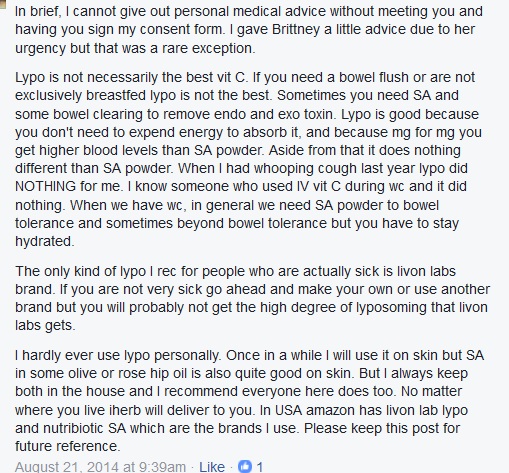DTaP: Whooping Cough – asymptomatic carriers
http://www.medscape.com/viewarticle/815247
http://www.nvic.org/NVIC-Vaccine-News/July-2012/ca-bill-to-restrict-personal-belief-vaccine-exempt.aspx#NVAC
Levi Quackenboss – You can’t Protect Another Person From Pertussis
Dr. Humphries on Tetanus, immunity and Epigenetics
https://youtu.be/hIgomZ06FFQ
Vaccinated healthcare worker passes whooping cough on to infants
http://www.health.gov.au/internet/main/publishing.nsf/Content/cda-cdi3404e.htm
Australia removes free DTaP vaccine due to lack of effectiveness
http://www.news.com.au/breaking-news/states-ending-free-parent-whooping-vaccine/story-e6frfku0-1226350174856
FDA admits vaccine contributes to whooping cough resurgence
See also:
If you have whooping cough:
Vitamin C protocol for Whooping Cough by Suzanne Humphries
(also a copy here on Dr. Suzanne’s website)
This was copied from a post Dr. Suzanne Humphries wrote when someone asked about what to do for their infant that had whooping cough.

Studies:
“Vaccination led to a 40-fold enhancement of B. parapertussis colonization in the lungs of mice.”
“these data suggest that the vaccine may be contributing to the observed rise in whooping cough incidence.”
http://www.ncbi.nlm.nih.gov/m/pubmed/20200027/
“we conclude that aP vaccination interferes with the optimal clearance of B. parapertussis”
http://www.nejm.org/doi/full/10.1056/NEJMoa1200850
Acellular pertussis vaccines protect against disease but fail to prevent infection and transmission in a nonhuman primate model.
http://www.ncbi.nlm.nih.gov/m/pubmed/24277828/
Despite widespread vaccination, whooping cough incidence is on the rise worldwide… vaccination led to a 40-fold enhancement of B. parapertussis colonization in the lungs of mice… these data suggest that the vaccine may be contributing to the observed rise in whooping cough incidence over the last decade by promoting B. parapertussis infection.”
http://www.ncbi.nlm.nih.gov/m/pubmed/20200027/
“Thus, we conclude that aP vaccination interferes with the optimal clearance of B. parapertussis and enhances the performance of this pathogen. Our data raise the possibility that widespread aP vaccination can create hosts more susceptible to B. parapertussis infection.” (Whooping Cough)
http://www.nejm.org/doi/full/10.1056/NEJMoa1200850
“Among 11, 531 children who received at least 4 doses of DPT, the risk of asthma was reduced to (1/2) in children whose first dose of DPT was delayed by more than 2 months. The likelihood of asthma in children with delays in all 3 doses was 0.39 (95% CI, 0.18-0.86).
http://www.ncbi.nlm.nih.gov/m/pubmed/18207561/
Effects of diphtheria-tetanus-pertussis or tetanus vaccination on allergies and allergy-related respiratory symptoms among children and adolescents in the United States. “The odds of having a history of asthma was twice as great among vaccinated subjects than among unvaccinated subjects. The odds of having had any allergy-related respiratory symptom in the past 12 months was 63% greater among vaccinated subjects than unvaccinated subjects. The associations between vaccination and subsequent allergies and symptoms were greatest among children aged 5 through 10 years.”
http://www.ncbi.nlm.nih.gov/m/pubmed/10714532/
Acellular pertussis vaccines protect against disease but fail to prevent infection and transmission in a nonhuman primate model.
http://www.ncbi.nlm.nih.gov/m/pubmed/24277828/
Whooping cough and pertussis vaccine: a comparison of risks and benefits in Britain during the period 1968-83.
“It is concluded that, in children living in non-deprived circumstances in Britain, the risk of pertussis vaccine during the period 1970-83 exceeded those of whooping cough.” “There were no deaths attributable to proven or suspected infections with Bordetella pertussis during the period 1972-1983. No cases of encephalopathy, permanent brain damage or lung damage were detected in a follow up of all cases notified, surveyed or admitted to hospital between 1975 and 1982.”
http://www.ncbi.nlm.nih.gov/m/pubmed/3835080/
Pertussis Outbreak, Washington, 2012
Overall, 758 of 1,000 (75.8%) patients aged 3 months–10 years were up-to-date with the childhood diphtheria and tetanus toxoids and acellular pertussis (DTaP) doses. Receipt of Tdap was documented in 97 of 225 (43.1%) patients aged 11–12 years and in 466 of 604 (77.2%) patients aged 13–19 years. Estimated DTaP coverage in Washington among children aged 19–35 months was 93.2% for ≥3 doses and 81.9% for ≥4 doses in 2010; Tdap coverage in adolescents aged 13–17 years was estimated at 70.6% (3).
http://www.cdc.gov/mmwr/preview/mmwrhtml/mm6128a1.htm
Adverse event reports after tetanus toxoid, reduced diphtheria toxoid, and acellular pertussis vaccines in pregnant women.
“We identified 132 reports of Tdap administered to pregnant women; 55 (42%) described no adverse event (AE). No maternal or infant deaths were reported. The most frequent pregnancy-specific AE was spontaneous abortion in 22 (16.7%) reports.”
http://www.ncbi.nlm.nih.gov/m/pubmed/22727350/
DTaP: Whooping Cough wanes after 5th year
http://www.nejm.org/doi/full/10.1056/NEJMoa1200850
